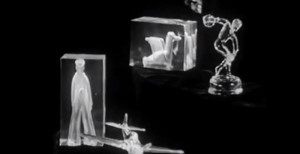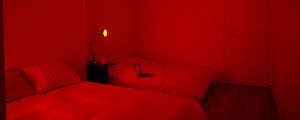If clothes don’t make the man, they sometimes reveal stellar artists and Danish fashion designer Henrik Vibskov is one of them. Celebrating the marriage of art and fashion like nobody else, his flexible approach led him into other fields of art like dance, theatre and music. Neck Plus Ultra, his first solo show at the Galeries Lafayette’s exhibit area, known as the Galerie des Galeries, is a multifaceted experience bringing together sight, touch and hearing; a synaesthesia for Paris’ ready-to-wear Mecca.

A pun on the Latin phrase nec plus ultra, (‘peak of perfection’), the exhibition title echoes Vibskov’s 2013 Autumn/Winter collection The Stiff Neck Chamber. In a way, he discards the social function of fashion, which usually aims to define types, instead lending a narrative function to it, as evidenced by the fact that he is always making something of a performance of his shows. The models become actors, the catwalk is transformed into a stage.

In the tradition of arts and crafts or the Vienna Workshops that used to mix architecture, arts and applied art at the beginning of the 20th century, Vibskov’s practice is underpinned by the concept of the ‘total work’. Indeed, he built his own system of interactions and self-references so that each pattern is as diminished as the disciplines explored. In these artistic expressions we see the unfolding of a story, told over his collections and exhibitions. This is particularly apparent with the flamingo, a central motif in his work at present. It has been a central element of his shows, even being adapted as a song by the electronic outfit, Trentemøller, for whom Vibskov drums.

Even though this exhibition operates autonomously, the artist takes his inspiration from Op Art, psychedelic aesthetics and Surrealism. From among the works on show, ‘Tunnel’ exemplifies this lineage. The starting point of this installation is the fabric. The orange and black material has been combined with a wood and metal frame, creating a powerful optical effect as 16 small tunnels rotate individually, resembling a drum carder in action.

A reference to a number of photographs by the Danish artist Richard Winther, ‘Fragile Soap Bodies’ is composed of a slow-motion film and stills depicting naked and distorted bodies, behind a soap-bubble wall built out from the frame of a clothes rack. The idea of deformation is less perceptibly found in ‘Foam Sculptures’ through the neck motif. These nylon socks, filled with expanding foam, consists of a collection of amorphous forms laid in glass cases. ‘Face Wool Explosions’ is a kind of three-dimensional abstract canvas. Here, Vibskov clearly experiments with using raw material, like wool, as a medium by fixing tufts in a wheel and trimming them to different lengths.

It would be difficult to appreciate the scope of Vibskov’s work at a glance. It’s a modest exhibition but enough to renew the debate over the relationship between art and fashion. It has been long accepted that fashion regularly makes forays into art. There was the famous Mondrian dress by Yves Saint Laurent, Cocteau and Dali blowing a breath of Surrealism into Schiaparelli’s world or, more recently, the Flemish masterpieces reinterpreted in Guillaume Henry’s collection for Carven. While on the other side, many artists have flirted with fashion, from the impressionist masters reproducing costumes from the era or Marc Quinn portraying Kate Moss as a yogi. But Henrik Vibskov goes beyond simply reciprocity and approaches his creations as a rhizome based on repetition.



















